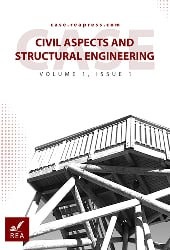Evaluation of Different Methods of Seismic Improvement of Structures for the Best Performance Against Progressive Failure
Abstract
In this study, the evaluation of the reinforcement of steel flexural frames against progressive failure was addressed. For this purpose, initially, two steel buildings with lateral load-bearing systems of flexural frames, whose number of floors is 3 and 5, respectively, were analyzed and designed in accordance with the national building regulations of Iran (Sections 6 and 10 and Regulation 2800). The initial analysis was performed using Etabs software. Subsequently, the perimeter frames of the buildings under study were reinforced against progressive failure by adding wind braces. The finite element software ABAQUS was used to simulate these frames. The variables under study included the number of floors (3 and 5 floors), the position of column removal in the plan (NO removal, removal of the corner column of the frame, removal of the middle column of the frame), and the position of column removal in the floors (Removal of columns in floors 1, 2, and 3). Thus, 16 steel frames were simulated and their behavior was compared with each other by examining outputs such as stress, strain, axial force of columns, and displacement of the column removal location. In the reinforced frames studied in terms of changes in the axial force of columns adjacent to the removal location, the most critical cases are those in which the middle column of the frame is removed at the lowest floor. In such a way that the ratio of the increase in the axial force of columns around the removal location in the case of removing the middle column in the three-story frame is approximately 2.15 times higher than the values corresponding to the cases of removing the corner columns. Also, the ratio of the increase in the axial force of columns around the removal location in the case of removing the middle column in the five-story frame is approximately between 5% and 49% higher than the values corresponding to the cases of removing the corner columns. On the other hand, with the increase in the number of floors, the maximum displacement of the column removal location has decreased. In such a way that depending on the position of the column removal location, the maximum displacements corresponding to the column removal location in the 5-story frames are approximately 7 to 22% lower than the values corresponding to the 3-story frames. Therefore, it can be stated that in steel flexural frames in which the solution of adding wind braces is used as a method of strengthening against progressive damage, the greater the number of floors, the greater the effectiveness of the mentioned method in improving the performance of the structure against progressive damage.
Keywords:
Progressive damage, Steel braces, Steel flexural frame, Finite element methodReferences
- [1] Ferraioli, M., Laurenza, B., Lavino, A., & De Matteis, G. (2024). Progressive collapse analysis and retrofit of a steel-RC building considering catenary effect. Journal of constructional steel research, 213, 108364. https://doi.org/10.1016/j.jcsr.2023.108364
- [2] Gerasimidis, S., & Sideri, J. (2016). A new partial-distributed damage method for progressive collapse analysis of steel frames. Journal of constructional steel research, 119, 233–245. https://doi.org/10.1016/j.jcsr.2015.12.012
- [3] Gul, F. A., Islam, M. R., Rahman, W., & Gul, F. A. (2017). Highland towers collapsed, the tragic story of Malaysia! International journal for research in social science and humanities, 3(2), 10–19. https://doi.org/10.53555/ssh.v3i2.321
- [4] Fu, F. (2012). Response of a multi-storey steel composite building with concentric bracing under consecutive column removal scenarios. Journal of constructional steel research, 70, 115–126. https://doi.org/10.1016/j.jcsr.2011.10.012
- [5] Kokot, S., & Solomos, G.(2012). Progressive collapse risk analysis: Literature survey, relevant construction standards and guidelines. Ispra: Joint research centre, european commission. https://www.academia.edu/download/82920580/lbna25625enn.pdf
- [6] Carstensen, C. (2009). Convergence of adaptive finite element methods in computational mechanics. Applied numerical mathematics, 59(9), 2119–2130. https://doi.org/10.1016/j.apnum.2008.12.006
- [7] Hibbitt, D., Karlsson, B., & Sorensen, P. (1995). Abaqus/CAE user’s manual. https://classes.engineering.wustl.edu/2009/spring/mase5513/abaqus/docs/v6.6/books/usi/default.htm
- [8] Guo, L., Gao, S., Fu, F., & Wang, Y. (2013). Experimental study and numerical analysis of progressive collapse resistance of composite frames. Journal of constructional steel research, 89, 236–251. https://doi.org/10.1016/j.jcsr.2013.07.006
- [9] Askarian, B., & Hashemi Rezvani, F. (2010). Investigation of progressive failure in braced steel frames. Fifth national congress of civil engineering. Mashhad, Iran. Civilica. (In Persian). https://civilica.com/doc/80678/
- [10] Khairuddin, A., & Fallahzadeh Fini, S. (2014). Investigation of the behavior of regular and irregular steel structures due to the phenomenon of progressive deterioration. The first national conference on the development of civil, architectural, electrical and mechanical engineering in Iran. Gorgan, Iran. Civilica. (In Persian). https://civilica.com/doc/325873/


